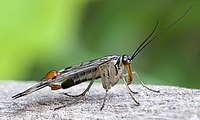
Colony growth of the bumblebee, Bombus terrestris, in improved and conventional agricultural and suburban habitats
Sign Up to like & getrecommendations! Published in 2017 at "Oecologia"
DOI: 10.1007/s004420100803
Abstract: Many bumblebee species are declining at a rapid rate in the United Kingdom and elsewhere. This is commonly attributed to the decline in floral resources that has resulted from an intensification in farming practices. Here… read more here.
Keywords: farmland; bombus terrestris; suburban areas; bumblebee bombus ... See more keywords

The role of noble bumblebee (Bombus terrestris) queen glycosaminoglycan in aged rat and gene expression profile based on DNA microarray.
Sign Up to like & getrecommendations! Published in 2021 at "Toxicological research"
DOI: 10.1007/s43188-020-00065-y
Abstract: Glycosaminoglycans (GAGs) have been used to diminish the deleterious effects associated with aging by preventing the destruction of cartilage, bone, discs, and skin. The objective of this study was to evaluate the anti-aging effect of… read more here.
Keywords: bombus terrestris; terrestris queen; terrestris; expression profile ... See more keywords

Northwestward range expansion of the bumblebee Bombus haematurus into Central Europe is associated with warmer winters and niche conservatism
Sign Up to like & getrecommendations! Published in 2020 at "Insect Science"
DOI: 10.1111/1744-7917.12800
Abstract: Species range expansions are crucial for understanding niche formation and the interaction with the environment. Here, we studied the bumblebee Bombus haematurus Kriechbaumer, 1870, a species historically distributed from northern Serbia through northern Iran which… read more here.
Keywords: expansion; central europe; bombus haematurus; bumblebee bombus ... See more keywords

Unveiling introgression in bumblebee (Bombus terrestris) populations through mitogenome-based markers.
Sign Up to like & getrecommendations! Published in 2019 at "Animal genetics"
DOI: 10.1111/age.12874
Abstract: The bumblebee, Bombus terrestris, is an important pollinator commercially used on a global scale. The exported subspecies B. t. terrestris has colonised diverse environments, in some cases displacing wild pollinators to the verge of local extinction. In… read more here.
Keywords: bombus terrestris; introgression; bumblebee bombus;

The rate of DNA synthesis in ovaries, fat body cells, and pericardial cells of the bumblebee (Bombus terrestris) depends on the stage of ovarian maturation
Sign Up to like & getrecommendations! Published in 2023 at "Frontiers in Physiology"
DOI: 10.3389/fphys.2023.1034584
Abstract: Bumblebees are important pollinators of plants worldwide and they are kept for commercial pollination. By studying the process of oogenesis, we can understand their ontogenetic developmental strategy and reproduction. We describe the anatomy of the… read more here.
Keywords: fat body; dna synthesis; bumblebee bombus; synthesis ... See more keywords

Parasite and Pesticide Impacts on the Bumblebee (Bombus terrestris) Haemolymph Proteome
Sign Up to like & getrecommendations! Published in 2023 at "International Journal of Molecular Sciences"
DOI: 10.3390/ijms24065384
Abstract: Pesticides pose a potential threat to bee health, especially in combination with other stressors, such as parasites. However, pesticide risk assessment tests pesticides in isolation from other stresses, i.e., on otherwise healthy bees. Through molecular… read more here.
Keywords: haemolymph; bumblebee bombus; pesticide impacts; parasite pesticide ... See more keywords

A Sublethal Concentration of Sulfoxaflor Has Minimal Impact on Buff-Tailed Bumblebee (Bombus terrestris) Locomotor Behaviour under Aversive Conditioning
Sign Up to like & getrecommendations! Published in 2023 at "Toxics"
DOI: 10.3390/toxics11030279
Abstract: Pesticide exposure has been cited as a key threat to insect pollinators. Notably, a diverse range of potential sublethal effects have been reported in bee species, with a particular focus on effects due to exposure… read more here.
Keywords: sulfoxaflor; aversive conditioning; tailed bumblebee; bumblebee bombus ... See more keywords